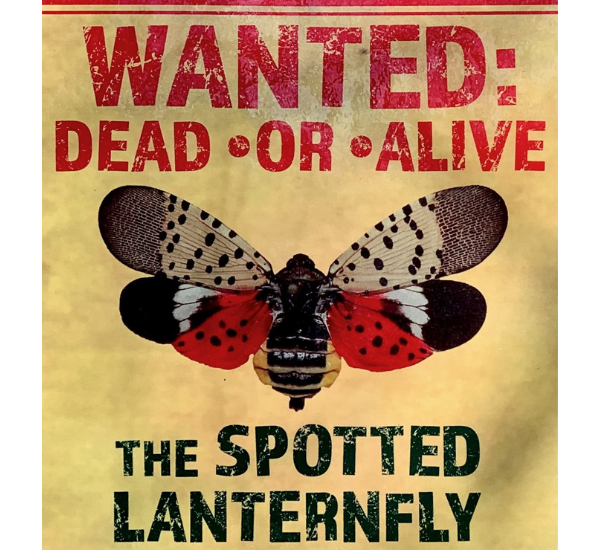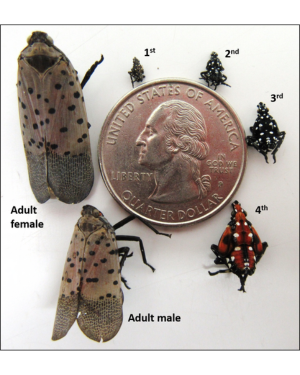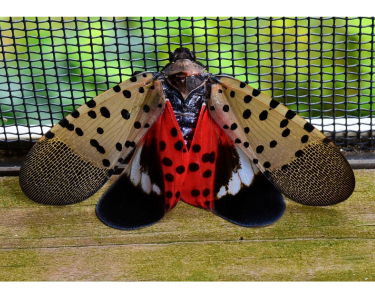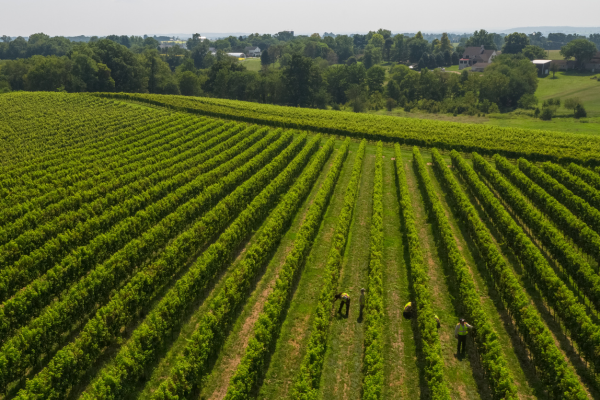The spotted lanternfly (Lycorma delicatula) is an invasive planthopper insect native to parts of China, India and Vietnam. First established in Pennsylvania, U.S.A. in 2014, it has since spread to several other American states, causing widespread concern. They were added to Canada’s regulated pest list in 2018 to help prevent future infestations. While the CFIA has not confirmed any established populations of spotted lanternfly in Canada at this time, they have received reports of spotted lanternfly observations in various locations.

Identifying the Spotted Lanternfly:
Recognizing the SLF in its various life stages is crucial for early detection and control. Luckily, this insect is not easily confused with any other insect known in Canada. The lifecycle of the SLF spans approximately one year and consists of four stages: egg, nymph, pre-adult and adult.
Here’s what to look for:

Egg Stage: Eggs are laid in the fall, typically from September to December, on tree trunks, stones and other smooth surfaces. The masses are grey to brown in colour and are covered in a waxy coating. They can appear as mud-like patches, each containing 30-50 eggs. The eggs overwinter and hatch in the spring.

Nymph Stage: After hatching in late spring, nymphs will seek a host species to feed on. The nymphs go through four stages, or instars. Early instars are black with white spots; later instars develop red patches. Nymphs are highly mobile and feed on a wide range of plants.
Pre-Adult Stage: By mid-summer, nymphs mature into adults. They begin to develop wings but are not yet fully capable of flight. They continue to feed aggressively on plant sap.

Adults: By late summer, adults are fully developed and capable of flight. Adults are about an inch long with distinctive grey forewings with black spots and striking red and black hindwings. Their legs and head are black, while their abdomen is yellow with black bands. When flying, their underwings show a brilliant red colour. Adults mate and lay eggs in the fall, completing the lifecycle.
Nymphs and adults tend to gather in large numbers on host plants. They are easiest to spot at dawn and dusk when moving around the tree.
Potential Host Trees in Ontario:
- Tree-of-heaven (Ailanthus altissima)
- Apple (Malus)
- Prunus spp. (Plums, cherries, peaches, nectarines, apricots)
- Pine (Pinus)
- Oak (Quercus)
- Walnut (Juglans)
- Willow (Salix)
- Maple (Acer)
- Sycamore (Platanus)
- Tulip tree (Liriodendron)
- Poplar (Populus)
How does SLF Impact our Urban Forest?
While the SLF is primarily considered an agricultural pest, it still poses a severe threat to Ontario's urban forests, and the potential impacts are significant.
Ecological Damage in Urban Areas: The SLF prefers to feed and lay eggs on the Tree of Heaven, but it also feeds on many other native hardwoods like maples, oaks and walnuts, which are common species found in our urban forest. The adults and nymphs are sapsuckers, meaning they feed on the phloem (internal tissues that carry sugars throughout the plant) of their host species. This leaves open wounds that seep sap, honeydew (sweet excretion from feeding) and frass (debris) all over the plant.
These remnants can attract other insects to feed on the foliage, and moisture build up around the wounds can encourage fungal growth, leading to mold. Additionally, the SLF sap-feeding reduces the health and vigor of trees, negatively impacting urban biodiversity.
Impact on Urban Agriculture: SLF feed on the sap of over 70 plant species, including those grown in urban gardens and community farms such as grapes, apples and hops. Their feeding habits can weaken plants, making them more susceptible to disease and less productive, which could harm urban agriculture initiatives and local food production efforts. This is particularly worrisome for Ontario’s wine industry close to the Canada-USA border.
Recreational Impacts in Urban Green Spaces: While SLF does not bite or sting humans, they can reduce the enjoyment of parks and green spaces in many ways. The sap and honeydew excretion can attract stinging insects such as wasps or hornets. The sticky honeydew can fall on people in parks, making their experiences unpleasant. Finally, SLF can swarm trees, causing wilting and canopy dieback, compromising the aesthetics.
Economic Costs in Cities: The economic implications of the SLF are substantial, including the increased cost of managing infested urban forests and gardens, potential crop loss in urban agriculture and decreased property values due to damaged trees and plants. Additionally, the need for increased pesticide use could have further environmental and health impacts on urban residents.
Addressing the threat of the spotted lanternfly in urban areas requires coordinated efforts from city planners, arborists and community members to better protect and preserve the health of our urban forest and green spaces.

Early Detection & Prevention:
Preventing the spread of SLF into Ontario’s urban forests requires vigilance and proactive measures. Here are five steps to help mitigate and manage the risk:
- Stay Vigilant: Learn how to identify SLF through its life stages and its preferred host, the tree-of-heaven. Educate others and stay up to date with current sighting reports. By doing so, you are playing a vital role in preventing the spread of this invasive species.
- Inspect & Report: Regularly check trees, outdoor furniture, vehicles and other hard surfaces for egg masses and insects. If you spot an SLF, report it through the Canadian Food Inspection Agency (CFIA) or EDDMapS Ontario.
- Stomp or Squash: If you see an SLF, you can simply stomp or squash it. This is a quick way to reduce their numbers.
- Scrape and Destroy Eggs: If you find egg masses, scrape them off surfaces, place them in a sealed bag with alcohol and dispose of them properly in the trash.
- Consult a Professional: If you have a confirmed infestation, it may be time to consult an ISA certified arborist to determine what treatments can be done for your trees to protect them from further damage.
- Collaborate:Join community efforts to monitor and manage invasive species like the SLF. Work with local groups to spread awareness and implement control measures.
For more information on the SLF, check out the Invasive Species Centre’s website here.
Jon is an ISA-certified arborist and LEAF's Residential Planting Programs Senior Field Coordinator.
LEAF offers a subsidized Backyard Tree Planting Program for private property. The program is supported by the City of Toronto, the Regional Municipality of York, the City of Markham, the Town of Newmarket, the Regional Municipality of Durham, the Town of Ajax, the Township of Brock, the Municipality of Clarington, the City of Oshawa, the City of Pickering, the Township of Scugog, the Town of Whitby and Ontario Power Generation.
